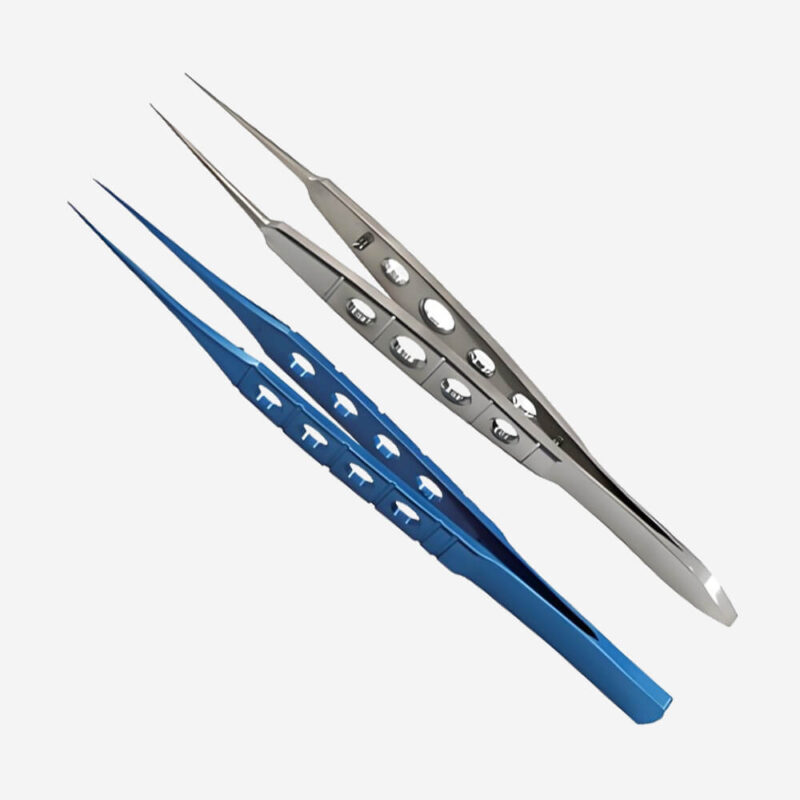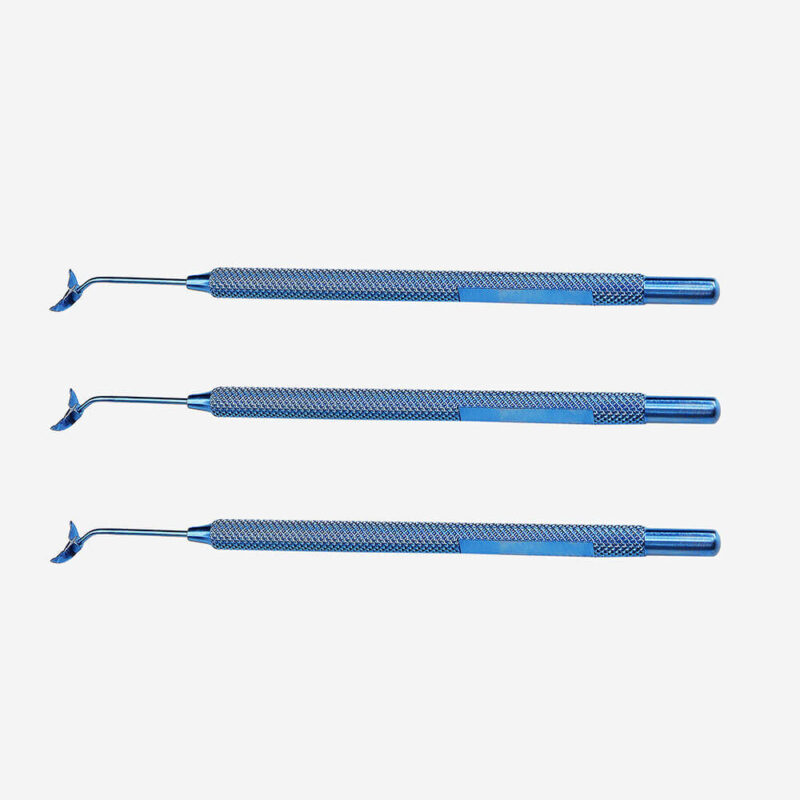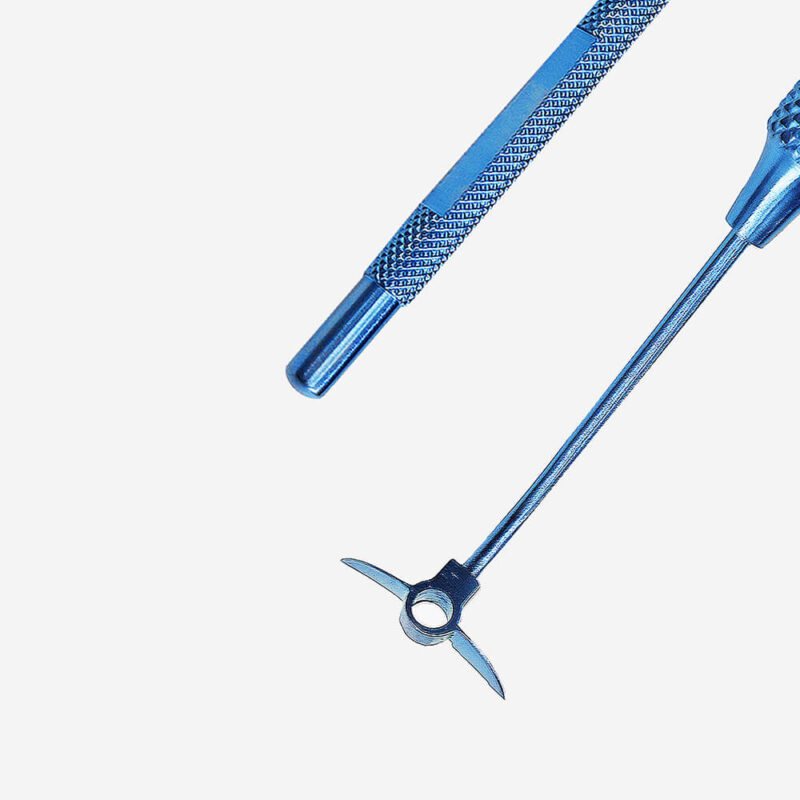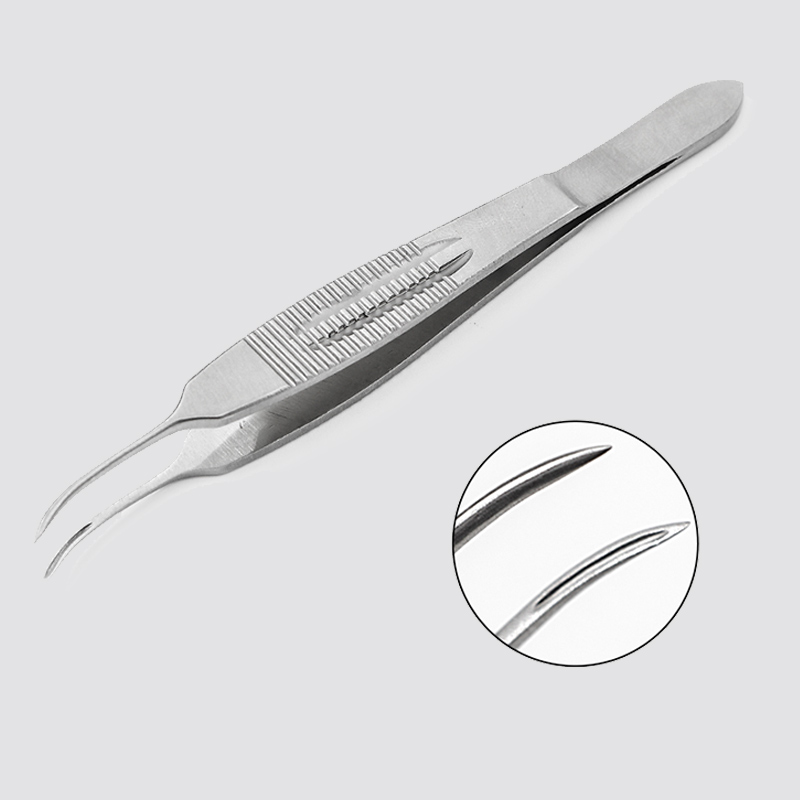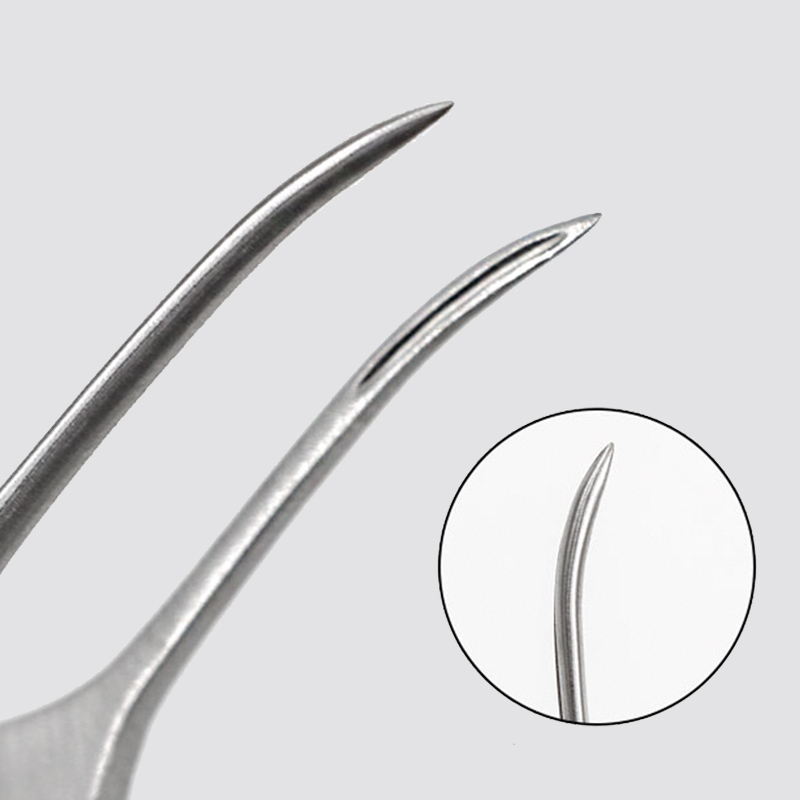What Are Surgical Sutures?
Surgical sutures, also known as stitches, are one of the most commonly used medical devices in surgeries and wound closures. They play a crucial role in helping wounds heal properly and reducing the risk of infections. In this section, we will delve into the different types of surgical sutures, their uses, and application methods. There are various types of surgical sutures available, each with its own unique characteristics to suit different types of wounds and procedures. The most common types include absorbable and non-absorbable sutures. Absorbable sutures are typically made from materials that break down naturally in the body over time. They eliminate the need for a second surgery to remove them and are suitable for internal tissue repairs such as deep wounds or internal organ surgeries. Some examples of absorbable sutures include polyglactin 910 (also known as Vicryl), polydioxanone (PDS), and catgut.
On the other hand, non-absorbable sutures do not break down in the body and require removal after a certain period. They come in various materials such as silk, nylon, polyester, or steel wire. These types of sutures are more suitable for external wound closures or permanent stitches needed to hold tissues together during healing.
Besides their composition, another important factor to consider when choosing surgical sutures is their size or thickness. Sutures come in different sizes indicated by numbers ranging from 3-0 (thinnest) to 7 (thickest). A higher number indicates a thinner suture which is ideal for delicate areas such as facial or cosmetic surgeries while lower numbers represent thicker ones used for heavy-duty applications like closing abdominal incisions.
Absorbable sutures are typically made from materials that break down naturally in the body over time. They eliminate the need for a second surgery to remove them and are suitable for internal tissue repairs such as deep wounds or internal organ surgeries. Some examples of absorbable sutures include polyglactin 910 (also known as Vicryl), polydioxanone (PDS), and catgut.
On the other hand, non-absorbable sutures do not break down in the body and require removal after a certain period. They come in various materials such as silk, nylon, polyester, or steel wire. These types of sutures are more suitable for external wound closures or permanent stitches needed to hold tissues together during healing.
Besides their composition, another important factor to consider when choosing surgical sutures is their size or thickness. Sutures come in different sizes indicated by numbers ranging from 3-0 (thinnest) to 7 (thickest). A higher number indicates a thinner suture which is ideal for delicate areas such as facial or cosmetic surgeries while lower numbers represent thicker ones used for heavy-duty applications like closing abdominal incisions.
 The type of thread pattern is also significant; it determines how well the suture will hold tissues together during healing. Common patterns include simple interrupted (individual stitches), continuous running (multiple stitches without tying off between them), mattress (used on areas under tension to prevent wound dehiscence), and lock-stitch (similar to a shoelace).
The application method and technique used for suturing also affect the healing process. Skilled medical professionals follow specific guidelines while closing wounds such as maintaining proper tension, avoiding infection, and minimizing scarring. In some cases, adhesives such as surgical glue or staples may be used instead of traditional sutures for certain types of wounds.
Surgical sutures are an indispensable part of modern medicine that greatly aids in the healing process. With advancements in technology, there has been a rise in the development of new suture materials and techniques that have led to better wound closure outcomes. It is essential to consult with a trained healthcare professional to determine the most suitable type of suture for your specific needs.
The type of thread pattern is also significant; it determines how well the suture will hold tissues together during healing. Common patterns include simple interrupted (individual stitches), continuous running (multiple stitches without tying off between them), mattress (used on areas under tension to prevent wound dehiscence), and lock-stitch (similar to a shoelace).
The application method and technique used for suturing also affect the healing process. Skilled medical professionals follow specific guidelines while closing wounds such as maintaining proper tension, avoiding infection, and minimizing scarring. In some cases, adhesives such as surgical glue or staples may be used instead of traditional sutures for certain types of wounds.
Surgical sutures are an indispensable part of modern medicine that greatly aids in the healing process. With advancements in technology, there has been a rise in the development of new suture materials and techniques that have led to better wound closure outcomes. It is essential to consult with a trained healthcare professional to determine the most suitable type of suture for your specific needs.
Alternative Tie Surgical Sutures Methods in Surgery
1, Single Interrupted Suture
The single interrupted suture is one of the most common types of sutures used in surgical procedures. It is known for its simplicity, accuracy, and versatility in various surgical applications. This type of suture involves using a single thread to close incisions or wounds by making individual knots at regular intervals along the length of the wound. The technique for performing a single interrupted suture begins with threading a sterile needle with an appropriate suture material. The size and strength of the suture material should be carefully chosen depending on the area being treated and the amount of tension expected on the wound closure. Once threaded, the needle is passed through both edges of the wound, starting from one end and exiting at a suitable distance from the edge.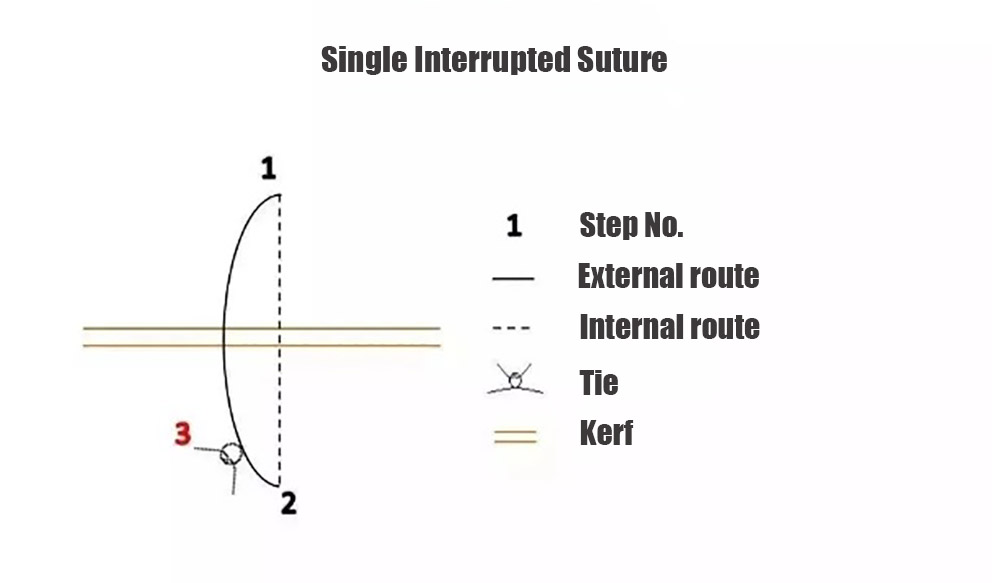 A key advantage of using single interrupted sutures is that they provide greater stability compared to continuous suturing techniques. By creating individual knots at regular intervals, this type of suture ensures that there is no failure point along the length of the wound closure. This helps to reduce tension on each individual knot, minimizing any chances of dehiscence (wound reopening) or poor healing.
Additionally, using single interrupted sutures allows for precise alignment and control over wound edges. As each stitch and knot is made separately, surgeons have more flexibility when it comes to fine-tuning wound closure to achieve optimal aesthetic outcomes. This level of precision can prove beneficial in areas where cosmetic appearance is particularly important, such as facial plastic surgeries or laceration repairs.
Furthermore, single interrupted sutures provide greater access to underlying tissues during follow-up examinations or procedures. Unlike continuous sutures where removing one stitch can lead to unraveling of others, removing a single interrupted stitch does not affect neighboring stitches or knots. This makes it easier for healthcare professionals to assess and manage potential complications such as infections or hematomas that may arise after surgery.
While there are various types of surgical suturing techniques available, the single interrupted suture remains a popular choice for its simplicity, flexibility, and strong wound closure capabilities. Whether used in minor procedures or complex surgeries, this technique has stood the test of time and continues to be a reliable method for achieving successful outcomes.
A key advantage of using single interrupted sutures is that they provide greater stability compared to continuous suturing techniques. By creating individual knots at regular intervals, this type of suture ensures that there is no failure point along the length of the wound closure. This helps to reduce tension on each individual knot, minimizing any chances of dehiscence (wound reopening) or poor healing.
Additionally, using single interrupted sutures allows for precise alignment and control over wound edges. As each stitch and knot is made separately, surgeons have more flexibility when it comes to fine-tuning wound closure to achieve optimal aesthetic outcomes. This level of precision can prove beneficial in areas where cosmetic appearance is particularly important, such as facial plastic surgeries or laceration repairs.
Furthermore, single interrupted sutures provide greater access to underlying tissues during follow-up examinations or procedures. Unlike continuous sutures where removing one stitch can lead to unraveling of others, removing a single interrupted stitch does not affect neighboring stitches or knots. This makes it easier for healthcare professionals to assess and manage potential complications such as infections or hematomas that may arise after surgery.
While there are various types of surgical suturing techniques available, the single interrupted suture remains a popular choice for its simplicity, flexibility, and strong wound closure capabilities. Whether used in minor procedures or complex surgeries, this technique has stood the test of time and continues to be a reliable method for achieving successful outcomes.
2, Single Continuous Suture
In traditional surgical suturing techniques, multiple interrupted sutures are used to close a wound. However, the use of a single continuous suture has become more popular in recent years due to its many advantages over interrupted sutures. A single continuous suture involves using one long thread to stitch the wound instead of individual stitches. The needle is inserted at one end of the wound and passed through the edges in a continuous manner until it reaches the other end. This technique requires only one knot at the beginning and another at the end, resulting in fewer knots compared to interrupted sutures. One of the main benefits of using a single continuous suture is its efficiency. With fewer knots, there is less time spent on tying them, which can be crucial during complex surgeries. Additionally, since there are no interruptions between stitches, there is less time wasted on repositioning the needle or thread. This results in decreased surgery time and improved patient outcomes.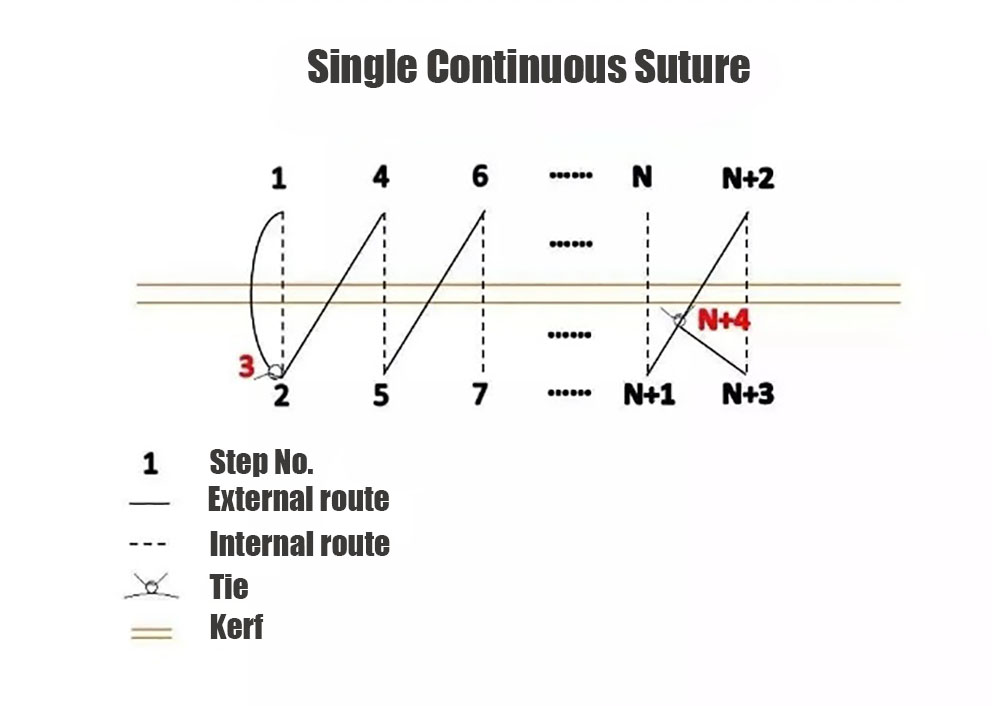 Furthermore, using a single continuous suture provides better wound closure compared to interrupted sutures. The constant tension along the entire length of the wound creates a more secure closure that prevents any gaps or openings for bacteria or other contaminants to enter. This also promotes better healing as it helps minimize scarring and decreases tissue reaction.
Another advantage of this technique is that it reduces needlestick injuries for surgeons and nurses. With only two ends to knot instead of multiple individual stitches, there are fewer opportunities for accidental pricks or cuts from needles during surgery.
Additionally, using a single continuous suture allows for better cosmetic results as it leaves behind minimal scarring. Interrupted sutures create visible puncture marks along the skin, while with this technique, these marks are eliminated except for where knots are tied.
While there are many benefits to using a single continuous suture, proper training, and technique are essential in achieving successful outcomes. Surgeons must have precise control over their hand movements when sewing to ensure the correct tension is maintained throughout the wound closure. They must also be skilled in tying secure knots at both ends to prevent any sutures from coming loose.
The single continuous suturing technique offers numerous advantages over traditional interrupted suturing. From increased efficiency and better wound closure to improved cosmetic outcomes and reduced risks of needlestick injuries, this technique is quickly becoming the preferred method for surgical sutures among medical professionals. With proper training and practice, surgeons can utilize this technique to achieve optimal results for their patients.
Furthermore, using a single continuous suture provides better wound closure compared to interrupted sutures. The constant tension along the entire length of the wound creates a more secure closure that prevents any gaps or openings for bacteria or other contaminants to enter. This also promotes better healing as it helps minimize scarring and decreases tissue reaction.
Another advantage of this technique is that it reduces needlestick injuries for surgeons and nurses. With only two ends to knot instead of multiple individual stitches, there are fewer opportunities for accidental pricks or cuts from needles during surgery.
Additionally, using a single continuous suture allows for better cosmetic results as it leaves behind minimal scarring. Interrupted sutures create visible puncture marks along the skin, while with this technique, these marks are eliminated except for where knots are tied.
While there are many benefits to using a single continuous suture, proper training, and technique are essential in achieving successful outcomes. Surgeons must have precise control over their hand movements when sewing to ensure the correct tension is maintained throughout the wound closure. They must also be skilled in tying secure knots at both ends to prevent any sutures from coming loose.
The single continuous suturing technique offers numerous advantages over traditional interrupted suturing. From increased efficiency and better wound closure to improved cosmetic outcomes and reduced risks of needlestick injuries, this technique is quickly becoming the preferred method for surgical sutures among medical professionals. With proper training and practice, surgeons can utilize this technique to achieve optimal results for their patients.
3, Continuous Lockstitch Suture
Continuous lockstitch suture is a common and versatile technique used in surgical suturing procedures. This method involves creating a series of interconnected stitches, which results in a secure and durable closure of the wound. The continuous lockstitch suture is particularly useful for long incisions or wounds that require multiple layers of sutures. It allows the surgeon to make consistent and evenly spaced knots along the entire length of the wound, reducing the risk of gaps or overlapping between stitches. This ensures a more uniform distribution of tension, resulting in better wound healing. The technique involves using one continuous strand of suture material, which eliminates the need for tying individual knots at each stitch, making it quicker and easier to perform. The needle enters and exits the tissue at an angle, creating interlocking loops with each pass-through. These loops are tightened by pulling on both ends of the suture until they are flush with the skin surface.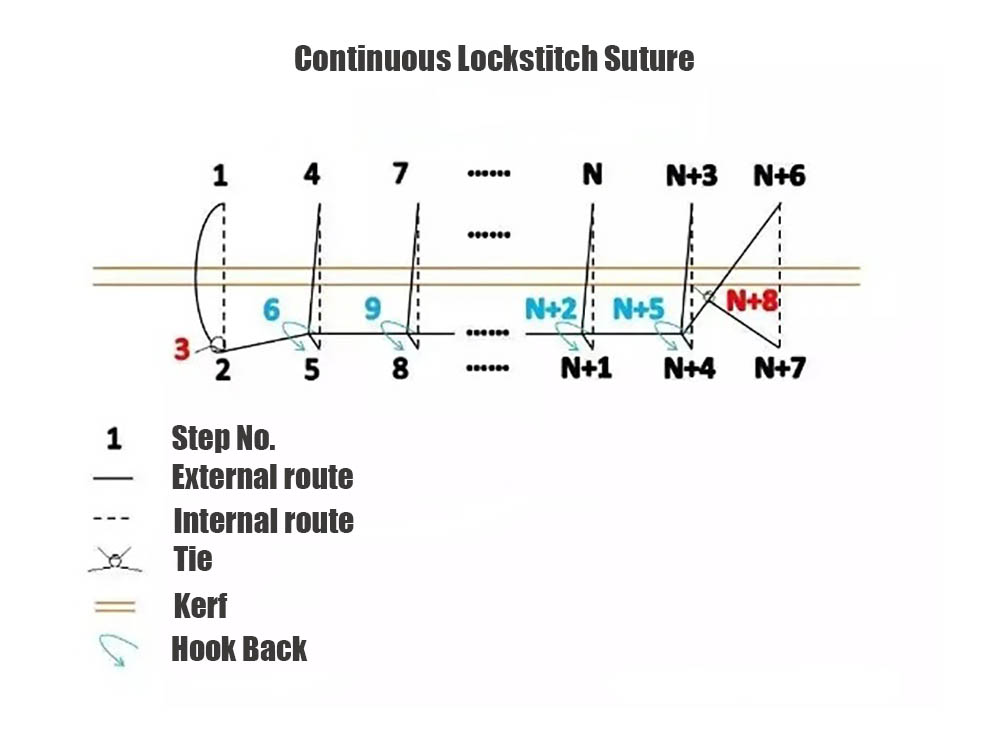 One major advantage of this type of suture is its ability to distribute tension evenly along the incision line. Unlike interrupted sutures where each stitch bears its own tension, continuous lockstitch sutures share tension throughout their entire length. This not only helps to prevent tissue damage but also reduces scarring and improves cosmetic outcomes.
Another benefit is that it provides a stronger hold than interrupted sutures as there is no space between stitches for bacteria or fluids to collect, reducing the risk of infection. Moreover, because there are fewer knots involved compared to other methods such as figure-of-eight or mattress sutures, there is less interference with blood flow around the incision site.
Continuous lockstitch suturing can also be used for different types of tissue closure such as subcutaneous layers or fascial layers without any modifications needed in technique. This makes it an adaptable method suitable for various surgical procedures like cesarean deliveries, hernia repairs, gastrointestinal surgeries, and plastic surgery operations.
However, despite its advantages, there are some limitations to this technique. Continuous lockstitch suturing may not be ideal for wounds in areas with high tension or heavy movements such as the joints or near the mouth, as it can cause “plow-out” or tearing of the skin. Additionally, if one stitch loosens, it can affect the entire suture line and cause potential complications.
Continuous lockstitch suture is a highly versatile and efficient technique for surgical sutures. Its ability to distribute tension evenly, provide a stronghold, and adaptability to different procedures makes it a preferred method among surgeons. With proper training and careful consideration of its limitations, this technique can achieve optimal results for wound closure.
One major advantage of this type of suture is its ability to distribute tension evenly along the incision line. Unlike interrupted sutures where each stitch bears its own tension, continuous lockstitch sutures share tension throughout their entire length. This not only helps to prevent tissue damage but also reduces scarring and improves cosmetic outcomes.
Another benefit is that it provides a stronger hold than interrupted sutures as there is no space between stitches for bacteria or fluids to collect, reducing the risk of infection. Moreover, because there are fewer knots involved compared to other methods such as figure-of-eight or mattress sutures, there is less interference with blood flow around the incision site.
Continuous lockstitch suturing can also be used for different types of tissue closure such as subcutaneous layers or fascial layers without any modifications needed in technique. This makes it an adaptable method suitable for various surgical procedures like cesarean deliveries, hernia repairs, gastrointestinal surgeries, and plastic surgery operations.
However, despite its advantages, there are some limitations to this technique. Continuous lockstitch suturing may not be ideal for wounds in areas with high tension or heavy movements such as the joints or near the mouth, as it can cause “plow-out” or tearing of the skin. Additionally, if one stitch loosens, it can affect the entire suture line and cause potential complications.
Continuous lockstitch suture is a highly versatile and efficient technique for surgical sutures. Its ability to distribute tension evenly, provide a stronghold, and adaptability to different procedures makes it a preferred method among surgeons. With proper training and careful consideration of its limitations, this technique can achieve optimal results for wound closure.
4, Intermittent Vertical Mattress Internal Rotation Suture
The intermittent vertical mattress internal rotation suture technique is a specialized method that is commonly used in surgical suturing. It involves a series of stitches placed at alternating depths, creating a strong and secure closure for wounds or incisions. This technique is particularly useful in areas with high tension, such as joints, where traditional suturing methods may not provide enough support. To understand this technique better, let’s break down its name. The term “intermittent” refers to the stitching pattern used, which alternates between deep and superficial layers of the tissue being sutured. The “vertical mattress” aspect refers to the direction in which the stitches are placed – perpendicular to the wound or incision line. Finally, “internal rotation” indicates that each stitch turns inward towards the wound before being tightened.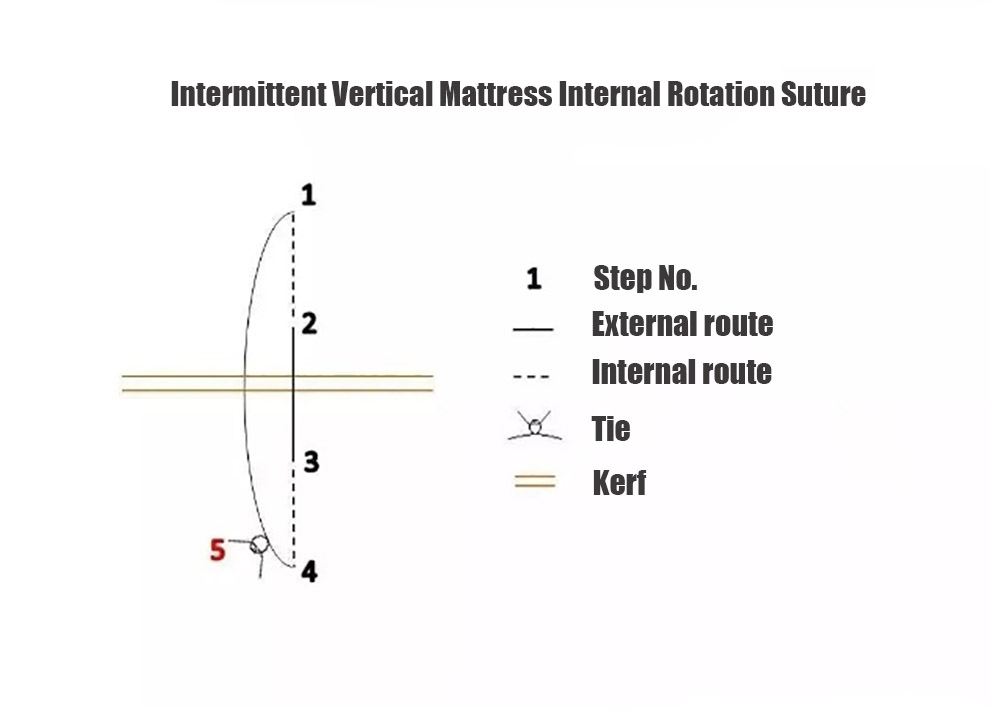 So how does this method differ from other types of sutures? Traditional techniques involve placing stitches parallel to the wound edges, resulting in a linear closure that can easily be disrupted by tension or movement. On the other hand, intermittent vertical mattress internal rotation sutures create a more robust and stable closure by incorporating different layers of tissue into each stitch.
The key to successfully performing this technique lies in understanding its placement and tensioning principles. As mentioned earlier, these sutures need to be placed perpendicular to the wound or incision line in an alternating fashion – going from deep tissues to superficial and back again. Additionally, proper tension must be applied during each stitch to ensure precise closure without causing any distortion or bunching of tissues.
One significant advantage of using intermittent vertical mattress internal rotation sutures is their ability to distribute tension evenly across multiple layers of tissue. This ensures proper healing and minimizes scarring while reducing the potential for post-operative complications such as infection or dehiscence (rupture).
While this technique may seem complex at first glance, it has proven benefits over traditional methods and has become increasingly popular among surgeons worldwide. It is particularly useful in orthopedic surgeries, plastic and reconstructive procedures, and wound closures that require additional support due to high tension or areas prone to movement.
The intermittent vertical mattress internal rotation suture technique is a valuable addition to any surgeon’s skillset. Its ability to create a robust closure that distributes tension evenly makes it an ideal choice for complex surgical cases. As with any suturing method, proper training and practice are essential for achieving optimal results.
So how does this method differ from other types of sutures? Traditional techniques involve placing stitches parallel to the wound edges, resulting in a linear closure that can easily be disrupted by tension or movement. On the other hand, intermittent vertical mattress internal rotation sutures create a more robust and stable closure by incorporating different layers of tissue into each stitch.
The key to successfully performing this technique lies in understanding its placement and tensioning principles. As mentioned earlier, these sutures need to be placed perpendicular to the wound or incision line in an alternating fashion – going from deep tissues to superficial and back again. Additionally, proper tension must be applied during each stitch to ensure precise closure without causing any distortion or bunching of tissues.
One significant advantage of using intermittent vertical mattress internal rotation sutures is their ability to distribute tension evenly across multiple layers of tissue. This ensures proper healing and minimizes scarring while reducing the potential for post-operative complications such as infection or dehiscence (rupture).
While this technique may seem complex at first glance, it has proven benefits over traditional methods and has become increasingly popular among surgeons worldwide. It is particularly useful in orthopedic surgeries, plastic and reconstructive procedures, and wound closures that require additional support due to high tension or areas prone to movement.
The intermittent vertical mattress internal rotation suture technique is a valuable addition to any surgeon’s skillset. Its ability to create a robust closure that distributes tension evenly makes it an ideal choice for complex surgical cases. As with any suturing method, proper training and practice are essential for achieving optimal results.
5, Continuous Parallelism Mattress Inward-flipping Suture
Continuous parallelism mattress inward-flipping suture is a technique used in surgical suturing that involves creating a continuous, parallel stitch pattern along the edges of a wound or incision. This type of suture is ideal for wounds that require precise and secure closure, such as those in the skin or internal organs. The basic procedure for performing a continuous parallelism mattress inward-flipping suture involves creating two rows of stitches on either side of the wound. The first row is made by inserting the needle from one edge to the other, then flipping it back and pulling it through, forming a loop. The needle is then reinserted into the same side and flipped again, creating another loop. This process is repeated until one entire row of stitches is complete.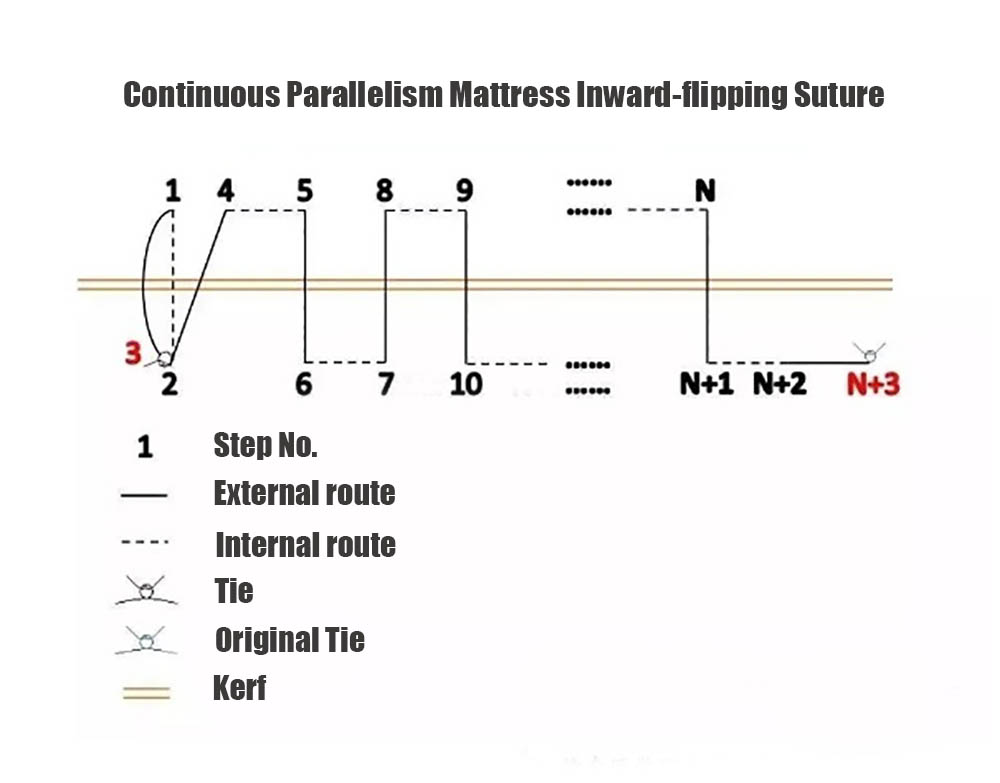 After completing the first row, the second row is created by flipping the direction of insertion so that each new stitch passes under the previous one. This creates an alternating series of loops between each row and helps to evenly distribute tension across the wound when tightened.
One of the main benefits of using this type of suture technique is its ability to minimize gaps between stitches. As each stitch forms a loop around both sides of the wound, there are no spaces left behind which could potentially lead to infection or tissue damage. Additionally, this method also allows for precise control over tension distribution along the edges of the wound.
The inward-flipping aspect refers to how each new stitch flips back underneath itself before being pulled through, resulting in all knots being buried inside the tissues rather than on top where they can cause discomfort or irritation. This not only provides greater comfort for patients but also reduces chances of infection or scarring.
This technique can be used in various types of surgeries such as cosmetic procedures, abdominal surgeries, and even heart surgeries due to its versatile nature and ability to provide strong and secure closure.
It’s important to note that proper training and experience are necessary when performing continuous parallelism mattress inward-flipping sutures. Surgeons must have a good understanding of wound healing and tension management to ensure the best outcomes for their patients.
Continuous parallelism mattress inward-flipping suture is a useful technique that offers strong, precise, and secure closure for surgical wounds. Its ability to minimize gaps between stitches and keep knots hidden within the tissues makes it an ideal choice for various types of surgeries. However, proper training and experience are crucial in performing this suture technique effectively.
After completing the first row, the second row is created by flipping the direction of insertion so that each new stitch passes under the previous one. This creates an alternating series of loops between each row and helps to evenly distribute tension across the wound when tightened.
One of the main benefits of using this type of suture technique is its ability to minimize gaps between stitches. As each stitch forms a loop around both sides of the wound, there are no spaces left behind which could potentially lead to infection or tissue damage. Additionally, this method also allows for precise control over tension distribution along the edges of the wound.
The inward-flipping aspect refers to how each new stitch flips back underneath itself before being pulled through, resulting in all knots being buried inside the tissues rather than on top where they can cause discomfort or irritation. This not only provides greater comfort for patients but also reduces chances of infection or scarring.
This technique can be used in various types of surgeries such as cosmetic procedures, abdominal surgeries, and even heart surgeries due to its versatile nature and ability to provide strong and secure closure.
It’s important to note that proper training and experience are necessary when performing continuous parallelism mattress inward-flipping sutures. Surgeons must have a good understanding of wound healing and tension management to ensure the best outcomes for their patients.
Continuous parallelism mattress inward-flipping suture is a useful technique that offers strong, precise, and secure closure for surgical wounds. Its ability to minimize gaps between stitches and keep knots hidden within the tissues makes it an ideal choice for various types of surgeries. However, proper training and experience are crucial in performing this suture technique effectively.
6, Intermittent Vertical Mattress Flared Suture
Intermittent vertical mattress flared suture is a modified version of the classic vertical mattress suture technique used in surgical suturing. It is commonly used in situations where there is significant tension on the wound or when tissue edges are difficult to align. This technique involves creating overlapping bites on the wound edges, resulting in a “flared” appearance, hence its name. The intermittent vertical mattress flared suture begins with a standard vertical mattress suture, where the needle enters and exits through both sides of the wound, forming a loop on either side. However, instead of completing the stitch by tying it off like a regular vertical mattress stitch, this technique involves taking an additional bite that overlaps with the previous one before continuing down the wound edge. The process is repeated until the entire wound edge has been stitched up.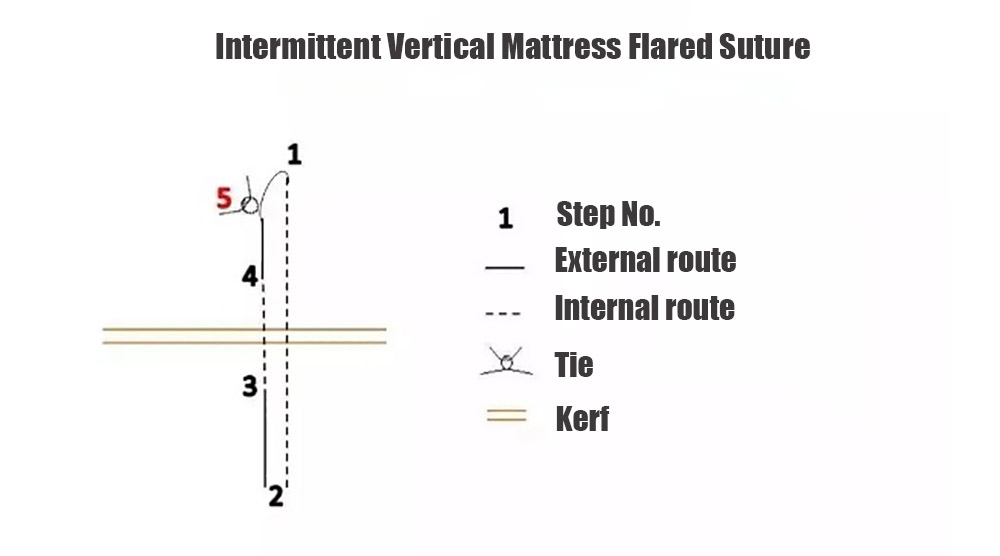 This modified technique offers several advantages over traditional suturing methods. Firstly, by overlapping each bite along the wound edge, more tension can be distributed evenly across each individual stitch rather than concentrated on one point. This reduces the risk of dehiscence (opening up) or compromised healing due to excessive tension at points of high stress.
Moreover, intermittent vertical mattress-flared sutures provide better support and stability to wounds that have uneven or irregular edges as it allows for greater manipulation and alignment during stitching. This feature makes this technique ideal for the closure of wounds with uneven layers such as those found in secondary intention healing or large skin flaps.
Another significant benefit of this type of suture is its ability to create hemostasis (control bleeding) within deep wounds. By securing overlapping bites along multiple layers of tissue, blood flow within deeper tissues can be reduced more effectively than with other techniques.
It’s important to note that while intermittent vertical mattress flared sutures offer many advantages over conventional techniques; they are not suitable for all types of wounds or patients. It may not be necessary for smaller wounds with minimal tension, and the additional knotting required for this technique may increase the risk of tissue strangulation or compromised blood flow. Therefore, it is essential to consult with a qualified medical professional before using this technique.
Intermittent vertical mattress flared suture is an effective and versatile surgical suturing technique that offers many benefits over traditional methods. Its ability to distribute tension evenly, provide stability to uneven wounds, and control bleeding makes it a valuable tool in wound closure. However, proper training and knowledge are crucial when using this method to ensure optimal outcomes for patients.
This modified technique offers several advantages over traditional suturing methods. Firstly, by overlapping each bite along the wound edge, more tension can be distributed evenly across each individual stitch rather than concentrated on one point. This reduces the risk of dehiscence (opening up) or compromised healing due to excessive tension at points of high stress.
Moreover, intermittent vertical mattress-flared sutures provide better support and stability to wounds that have uneven or irregular edges as it allows for greater manipulation and alignment during stitching. This feature makes this technique ideal for the closure of wounds with uneven layers such as those found in secondary intention healing or large skin flaps.
Another significant benefit of this type of suture is its ability to create hemostasis (control bleeding) within deep wounds. By securing overlapping bites along multiple layers of tissue, blood flow within deeper tissues can be reduced more effectively than with other techniques.
It’s important to note that while intermittent vertical mattress flared sutures offer many advantages over conventional techniques; they are not suitable for all types of wounds or patients. It may not be necessary for smaller wounds with minimal tension, and the additional knotting required for this technique may increase the risk of tissue strangulation or compromised blood flow. Therefore, it is essential to consult with a qualified medical professional before using this technique.
Intermittent vertical mattress flared suture is an effective and versatile surgical suturing technique that offers many benefits over traditional methods. Its ability to distribute tension evenly, provide stability to uneven wounds, and control bleeding makes it a valuable tool in wound closure. However, proper training and knowledge are crucial when using this method to ensure optimal outcomes for patients.
7, Intermittent Parallelism Mattress Flared Suture
Intermittent parallelism mattress flared suture is a specialized technique used in surgical suturing that offers several advantages over traditional methods. This innovative technique involves the use of a specific type of suture, known as a flared suture, that is designed to create an intermittent parallel pattern along the wound edges. One of the main benefits of using this method is its ability to distribute tension evenly across the wound edges. The intermittent parallelism created by this technique helps in reducing tension on each individual stitch, thus minimizing tissue damage and promoting faster healing. This makes it particularly useful for wounds that are under high amounts of stress or require extended healing time. Another advantage of using intermittent parallelism mattress flared sutures is their increased holding strength. As compared to traditional suturing methods, this technique allows for better tissue approximation and tighter closure of incisions. This not only reduces the risk of dehiscence (wound opening) but also increases the overall stability and strength of the wound during healing.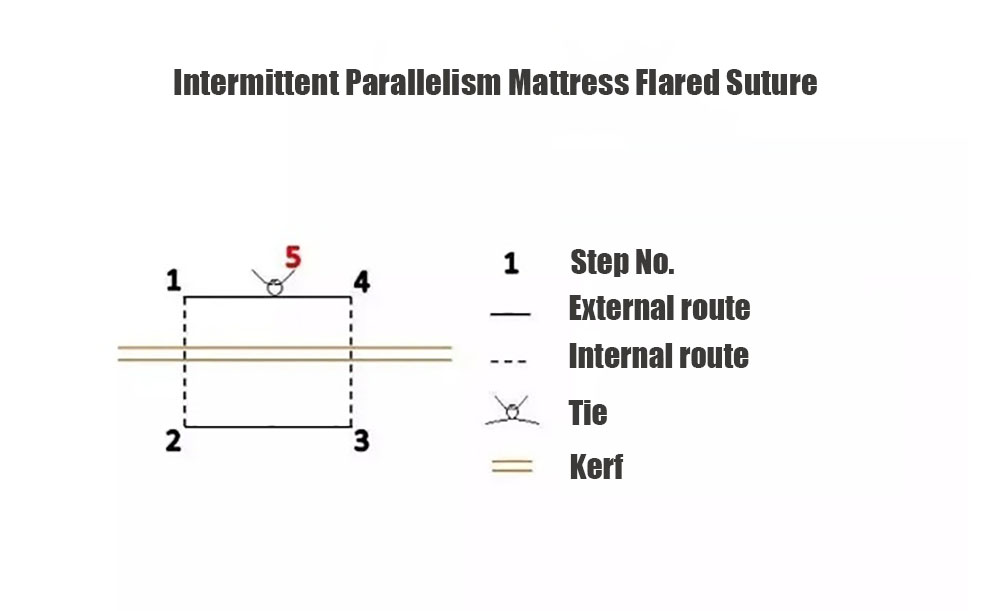 Additionally, this method minimizes knotting and tangling of sutures as they are secured at fixed points on either side of the wound rather than being tied off continuously along its length. This reduces potential complications such as tissue strangulation or ischemia (reduced blood flow), which can hinder proper wound healing.
Moreover, intermittent parallelism mattress flared sutures provide more control and precision during placement. The flared design helps in creating larger bites into the tissue without causing excessive distortion or trauma to surrounding tissues. This allows surgeons to accurately align wound edges and close any gaps more effectively, resulting in better cosmetic outcomes.
Furthermore, this technique can be utilized in various types of surgeries, including plastic surgery procedures like facelifts or breast augmentations where precise alignment and minimal scarring are critical factors for successful outcomes.
Intermittent parallelism mattress flared sutures offer numerous benefits for surgical closures such as reduced tension, increased holding strength, and improved precision and control. With its ability to promote faster healing and minimize potential complications, it has become a popular choice among surgeons for a wide range of procedures. This technique highlights the continual advancements in surgical methods and serves as a testament to the constant pursuit of improving patient outcomes in the medical field.
Additionally, this method minimizes knotting and tangling of sutures as they are secured at fixed points on either side of the wound rather than being tied off continuously along its length. This reduces potential complications such as tissue strangulation or ischemia (reduced blood flow), which can hinder proper wound healing.
Moreover, intermittent parallelism mattress flared sutures provide more control and precision during placement. The flared design helps in creating larger bites into the tissue without causing excessive distortion or trauma to surrounding tissues. This allows surgeons to accurately align wound edges and close any gaps more effectively, resulting in better cosmetic outcomes.
Furthermore, this technique can be utilized in various types of surgeries, including plastic surgery procedures like facelifts or breast augmentations where precise alignment and minimal scarring are critical factors for successful outcomes.
Intermittent parallelism mattress flared sutures offer numerous benefits for surgical closures such as reduced tension, increased holding strength, and improved precision and control. With its ability to promote faster healing and minimize potential complications, it has become a popular choice among surgeons for a wide range of procedures. This technique highlights the continual advancements in surgical methods and serves as a testament to the constant pursuit of improving patient outcomes in the medical field.
8, Interior Figure-of-eight Suture
Interior Figure-of-eight suture is a type of surgical suturing technique that is commonly used in closing deep wounds or incisions. It is also known as a buried figure-of-eight suture due to its positioning within the layers of tissue. This method involves passing the needle and thread in a criss-cross pattern through multiple layers of tissue, creating an “X” shape with each pass. The name “figure-of-eight” comes from the way the stitches look like when completed, resembling the number eight. The primary purpose of using this type of suture is to provide strong wound closure and promote optimal healing while minimizing scarring. The figure-of-eight pattern creates tension on the wound edges, pulling them together tightly and evenly. This helps prevent any gaps between tissues, reducing the risk of infection and promoting faster healing. One advantage of using an interior figure-of-eight suture is that it doesn’t leave any visible marks on the surface of the skin since it’s placed inside the layers of tissue. This makes it an ideal choice for cosmetic surgeries or wounds located in more visible areas such as the face or hands.
To perform this technique, surgeons use a curved needle with an attached thread made from non-absorbable material like nylon or silk. This ensures that the stitches remain intact for a longer time, giving enough time for proper healing to occur before they can be removed.
During surgery, after making an incision and repairing any damaged structures underneath, surgeons will begin stitching up the wound by placing deep sutures first using a figure-of-eight technique. These stitches are usually made slightly wider than other types to provide better support and pulling power for closure.
Once all deep stitches are in place, superficial ones are then added to the top to secure the edges of the skin together. This layered approach allows for a stronger closure that can withstand tension caused by movement or strain on tissues during recovery.
In addition to its effectiveness in wound closure, interior figure-of-eight sutures are also used in certain reconstructive surgeries or repairing damaged nerves and muscles. The technique can also be adapted for use in other areas of the body, such as within the bladder or intestines.
Interior figure-of-eight suture is a valuable technique used in surgical procedures to provide a strong and cosmetically appealing closure. Its ability to distribute tension evenly across tissues makes it a preferred choice for surgeons when closing deeper wounds or incisions.
One advantage of using an interior figure-of-eight suture is that it doesn’t leave any visible marks on the surface of the skin since it’s placed inside the layers of tissue. This makes it an ideal choice for cosmetic surgeries or wounds located in more visible areas such as the face or hands.
To perform this technique, surgeons use a curved needle with an attached thread made from non-absorbable material like nylon or silk. This ensures that the stitches remain intact for a longer time, giving enough time for proper healing to occur before they can be removed.
During surgery, after making an incision and repairing any damaged structures underneath, surgeons will begin stitching up the wound by placing deep sutures first using a figure-of-eight technique. These stitches are usually made slightly wider than other types to provide better support and pulling power for closure.
Once all deep stitches are in place, superficial ones are then added to the top to secure the edges of the skin together. This layered approach allows for a stronger closure that can withstand tension caused by movement or strain on tissues during recovery.
In addition to its effectiveness in wound closure, interior figure-of-eight sutures are also used in certain reconstructive surgeries or repairing damaged nerves and muscles. The technique can also be adapted for use in other areas of the body, such as within the bladder or intestines.
Interior figure-of-eight suture is a valuable technique used in surgical procedures to provide a strong and cosmetically appealing closure. Its ability to distribute tension evenly across tissues makes it a preferred choice for surgeons when closing deeper wounds or incisions.
9, External Figure-of-eight Suture
External Figure-of-eight sutures are a commonly used technique in surgical sutures that provides strong and secure wound closure. As the name suggests, this type of suture follows a figure-eight pattern, passing over and under the skin on either side of the incision. This creates a series of loops that hold the edges of the wound together, providing tension-free closure and promoting proper healing. The main advantage of using an external figure-of-eight suture is its ability to distribute tension evenly across the wound edges. This prevents any one point from experiencing too much stress, reducing the risk of wound dehiscence or separation. Additionally, because this method involves passing through multiple tissue layers instead of just skin, it provides better support for deeper structures such as muscles and tendons.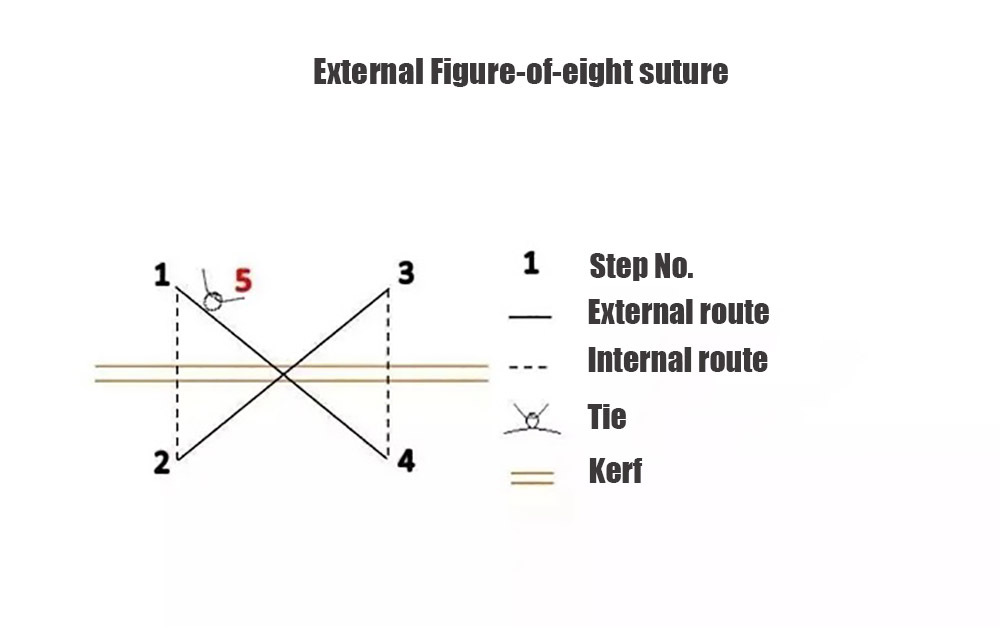 To perform an external figure-of-eight suture, first, make sure that your needle is loaded with a suitable thread or suture material. Start by inserting the needle at one end of the incision and pulling it out on the opposite side, creating a loop on top of the wound. Then pass the needle back in through both sides of this loop before bringing it out again at the other end of the incision.
Next, form another loop by passing your needle over and under both sides of this new thread segment before pulling it tight. This essentially creates two loops on either side – one above and one below – which will serve as your figure eight pattern. Repeat this process until you reach the end of your incision line.
Once you have completed your initial set-up stitches in this manner, continue making additional passes along each edge while maintaining tension on both loops to ensure proper approximation. You may also choose to add more interconnected sets if needed depending on how long your wound is or if there are any deep structures requiring reinforcement.
As you approach closure towards one end or when you have reached maximum tension using all available segments you may proceed with tying off the knot and completing the external figure-of-eight suture. Alternatively, removing the individual loops of the pattern one by one with a pair of sterile scissors once they have served their purpose can also minimize scarring as compared to a single cut in the middle during removals.
External figure-of-eight suture is an effective technique for securing wound edges while promoting proper healing and minimizing complications. Although it may take more time and effort compared to other methods, it can provide superior support and tension distribution, making it a valuable option for surgical sutures.
To perform an external figure-of-eight suture, first, make sure that your needle is loaded with a suitable thread or suture material. Start by inserting the needle at one end of the incision and pulling it out on the opposite side, creating a loop on top of the wound. Then pass the needle back in through both sides of this loop before bringing it out again at the other end of the incision.
Next, form another loop by passing your needle over and under both sides of this new thread segment before pulling it tight. This essentially creates two loops on either side – one above and one below – which will serve as your figure eight pattern. Repeat this process until you reach the end of your incision line.
Once you have completed your initial set-up stitches in this manner, continue making additional passes along each edge while maintaining tension on both loops to ensure proper approximation. You may also choose to add more interconnected sets if needed depending on how long your wound is or if there are any deep structures requiring reinforcement.
As you approach closure towards one end or when you have reached maximum tension using all available segments you may proceed with tying off the knot and completing the external figure-of-eight suture. Alternatively, removing the individual loops of the pattern one by one with a pair of sterile scissors once they have served their purpose can also minimize scarring as compared to a single cut in the middle during removals.
External figure-of-eight suture is an effective technique for securing wound edges while promoting proper healing and minimizing complications. Although it may take more time and effort compared to other methods, it can provide superior support and tension distribution, making it a valuable option for surgical sutures.
Choosing the Right Method of Surgical Suture for Different Surgeries
Choosing the right method of surgical suture is a critical aspect of any surgery. The type of suture and technique used can greatly affect the healing process and overall outcome of the procedure. In this section, we will discuss various factors that should be considered when selecting a suitable method of surgical suture for different surgeries.
vector illustration of sewing up the wound with surgical needle
1. Wound Location:
The location of the wound plays a crucial role in deciding which type of suture to use. For example, wounds on areas with high tension such as joints or extremities may require a stronger and more durable suture material like nylon or polypropylene. On the other hand, wounds on delicate areas like the face or hands may need a finer and more precise suture material such as monofilament synthetic absorbable sutures.2. Tissue Type:
The type of tissue being secured also determines the choice of surgical suturing methods. For example, soft tissues like muscle or fat require deep sutures that can withstand pressure and tension during movement. On the other hand, superficial wounds in thin skin areas may only require surface stitches using fine sutures that minimize scarring.3. Characteristics of Sutures:
Another essential factor to consider is the characteristics of different types of sutures available in the market. Absorbable sutures are often preferred for internal surgeries where they dissolve over time leaving no trace behind while promoting healing from within. Non-absorbable sutures are commonly used for external incisions that are visible post-surgery and need to be removed after proper wound healing.4. Surgical Technique:
Different types of surgeries require specific techniques to ensure proper closure and promote faster healing rates. Sutures must align perfectly well with each other for optimum closure at all levels including fascia (tissues beneath skin), subcuticular (beneath epidermis), dermal tissue (above dermis). Depending on these factors, surgeons might choose continuous stitching techniques vs. interrupted stitches or repairing the layers of tissue separately vs. all together.5. Patient Factors:
Each patient’s medical history and condition need to be taken into consideration before selecting a suitable suture method. Some patients may have allergies or hypersensitivity to certain suture materials, while others may have underlying health conditions that require slow-absorbing sutures which can take more time for complete healing. Choosing the right method of surgical suture is a crucial decision that needs to be made after careful evaluation of various factors. These include wound location, tissue type, suture characteristics, surgical technique, and patient factors. Consulting with an experienced surgeon and understanding the unique requirements of each surgery can help in determining the most appropriate suture method for optimal healing and successful outcomes.The Surgical Tool You May Like
Titanium Halstead Mosquito Hemostatic Forceps Straight & Curved Surgical Equipment
¥29.00
Straight Toothed Ophthalmic Suture Forceps Surgical Instrument 1*2 Tooth with Four-hole
¥23.00 – ¥25.00
Ophthalmic Adson Tissue Forceps for Eye Surgery with Teeth
¥17.00 – ¥19.00
Plastic Eye Shield Ventilated Clear Eye Care with 8/9 Holes
¥18.00
Stainless Utrata Capsulorhexis Forceps Ophthalmic Instrument with Flat Handle
¥21.00
Stainless Steel Double Ended Tongue Thyroid Farabeuf Retractor
¥18.90 – ¥28.90
Titanium Toric Corneal Marker 2 Claws Ophthalmic Corneal Surgery Marker
¥21.00
Straight Ophthalmic Suture Tying Forceps Surgical Instrument 1*2 Tooth with Three-hole
¥25.00
Intraocular Retinal Capsulorhexis Scissors Ophthalmic Instrument 20G/23G/25G/27G
¥200.00 – ¥230.00

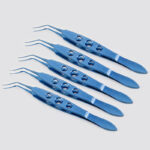 Capsulorhexis Forceps
Capsulorhexis Forceps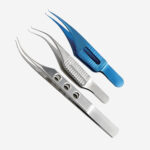 Suture Forceps
Suture Forceps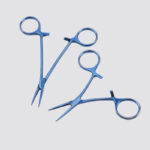 Hemostatic Forceps
Hemostatic Forceps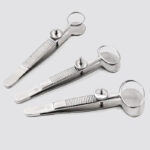 Chalazion Forceps
Chalazion Forceps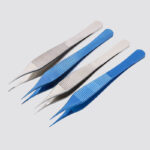 Adson Forceps
Adson Forceps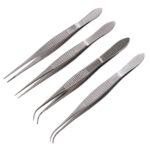 Tissue Forceps
Tissue Forceps

